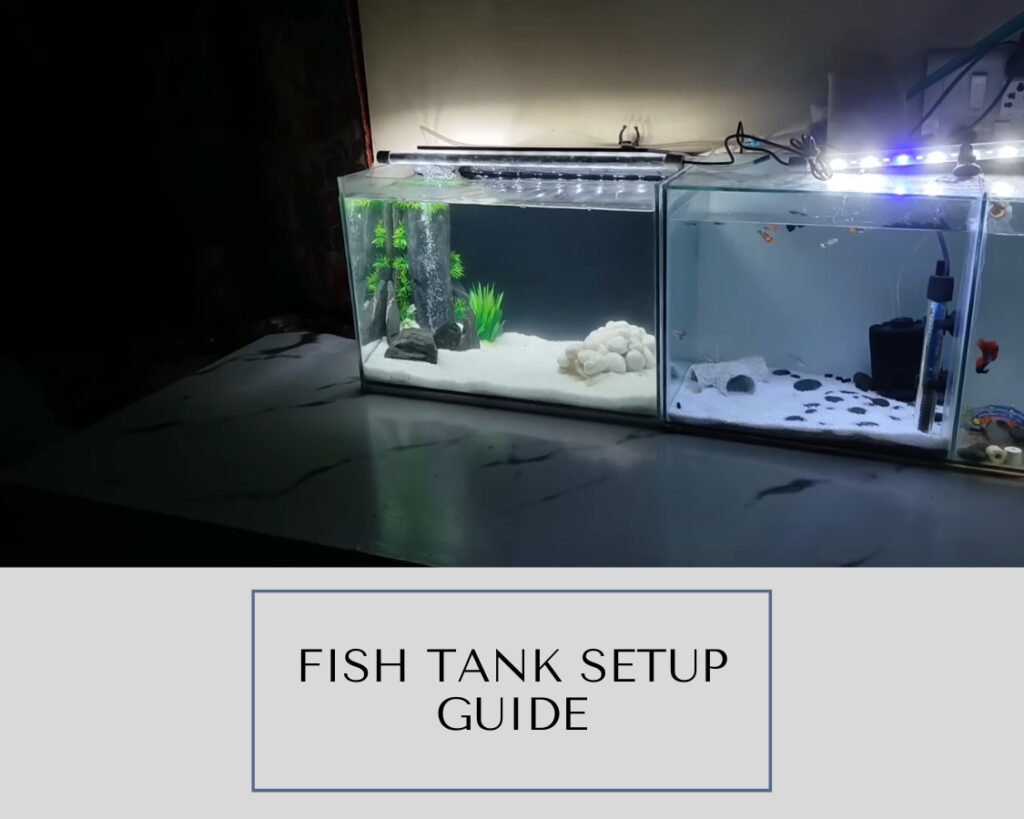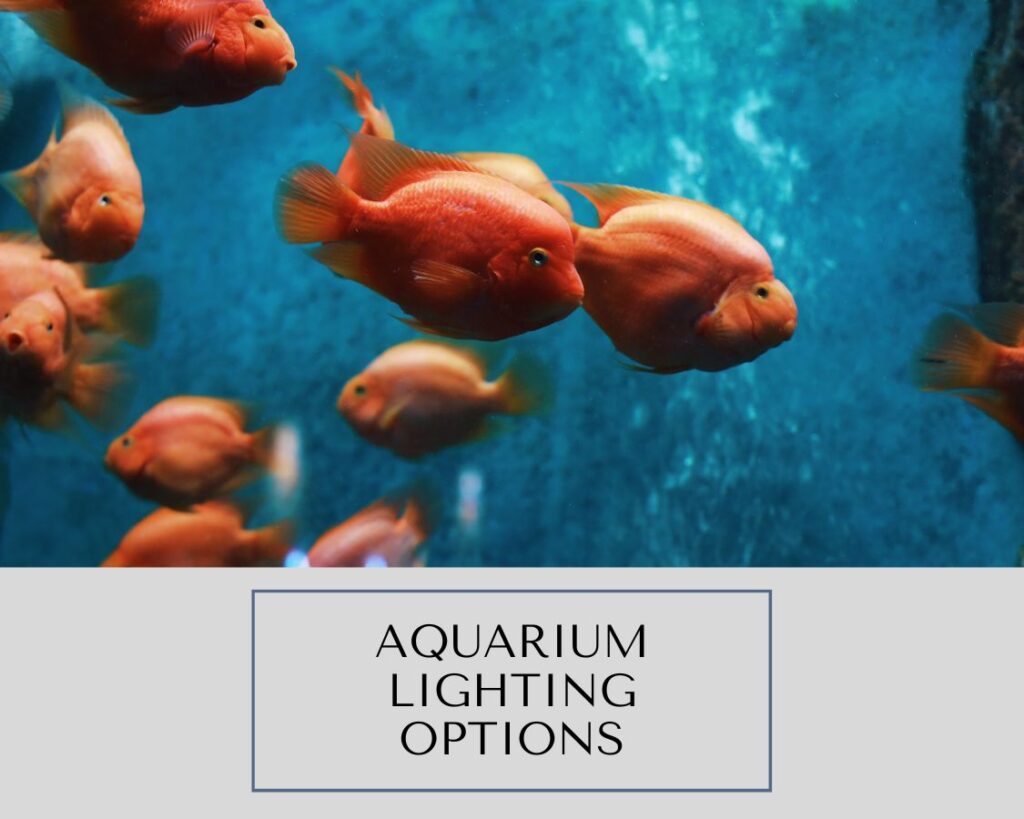Setting up a fish tank is more than just a pastime; it’s a gateway to an enchanting aquatic world waiting to be explored. When done correctly, this delightful hobby promises personal satisfaction and ensures the well-being and contentment of your aquatic companions.
In this extensive and user-friendly guide, we embark on a journey to establish the perfect fish tank environment. From the pivotal task of selecting an appropriately sized tank to the ongoing maintenance necessary for pristine water quality and the art of harmoniously pairing fish species, consider us your seasoned companions on this aquatic adventure. So, let’s immerse ourselves in the art and science of creating a thriving underwater ecosystem without further trouble!
Picking the Right Tank
When creating the perfect aquatic haven for your friends, the first step is selecting the right tank. This decision forms the foundation of your aquatic venture, impacting the aesthetics of your living space and, more importantly, the comfort and health of your aquatic companions.
Deciding the Tank Size
Size indeed matters when it comes to fish tanks. Your aquarium’s very dimensions can significantly influence your aquatic denizens’ overall well-being. To make an informed choice, consider two vital factors:
Space Availability: Survey your living space to determine the ideal location for your fish tank. This includes measuring available floor space and ensuring it can comfortably accommodate the dimensions of your chosen tank.
Fish Type: Different fish species have varying space requirements. As a general rule, allocate at least one gallon of water per inch of fish. However, it’s worth noting that some species may need more space due to their specific behaviors or territorial nature. Research your intended fish thoroughly to ensure they thrive in your desired tank size.
Selecting the correct tank size is not just about giving your fish room to swim; it’s about creating an environment where they can flourish and express their natural behaviors.
Tank Shape and Material
Now that you’ve determined the size, it’s time to consider the shape and material of your tank. These choices can have a substantial impact on both the aesthetics and functionality of your aquatic display:
Tank Shape: Rectangular or square-shaped tanks are preferred for a reason. Their elongated dimensions provide ample swimming space for your fish, allowing them to navigate comfortably. Curved or uniquely shaped tanks may look captivating but can sometimes limit the swimming area, potentially causing stress to your aquatic companions.
Tank Material: Glass and acrylic are the two primary materials used for aquariums, each with its own advantages and considerations.
- Glass Tanks: These are the more traditional and common choice. They are durable, scratch-resistant, and provide excellent clarity for viewing your fish. However, they can be heavier than acrylic tanks and may require sturdier support structures.
- Acrylic Tanks: Acrylic tanks are lighter and more impact-resistant than glass tanks. They can be molded into various shapes, offering flexibility in design. However, they are more prone to scratches and can require extra care during cleaning to avoid damaging the surface.
Choosing between glass and acrylic ultimately depends on your preferences and priorities. If you prioritize durability and scratch resistance, glass may be your top pick. On the other hand, if you value flexibility in design and are willing to take extra precautions, acrylic might be your choice.
Selecting the right tank size, shape, and material is a pivotal step in creating a thriving aquatic habitat. It’s an investment in the well-being of your aquatic companions and a testament to your commitment to this captivating hobby. So, take your time, consider your options, and confidently embark on this exciting journey.
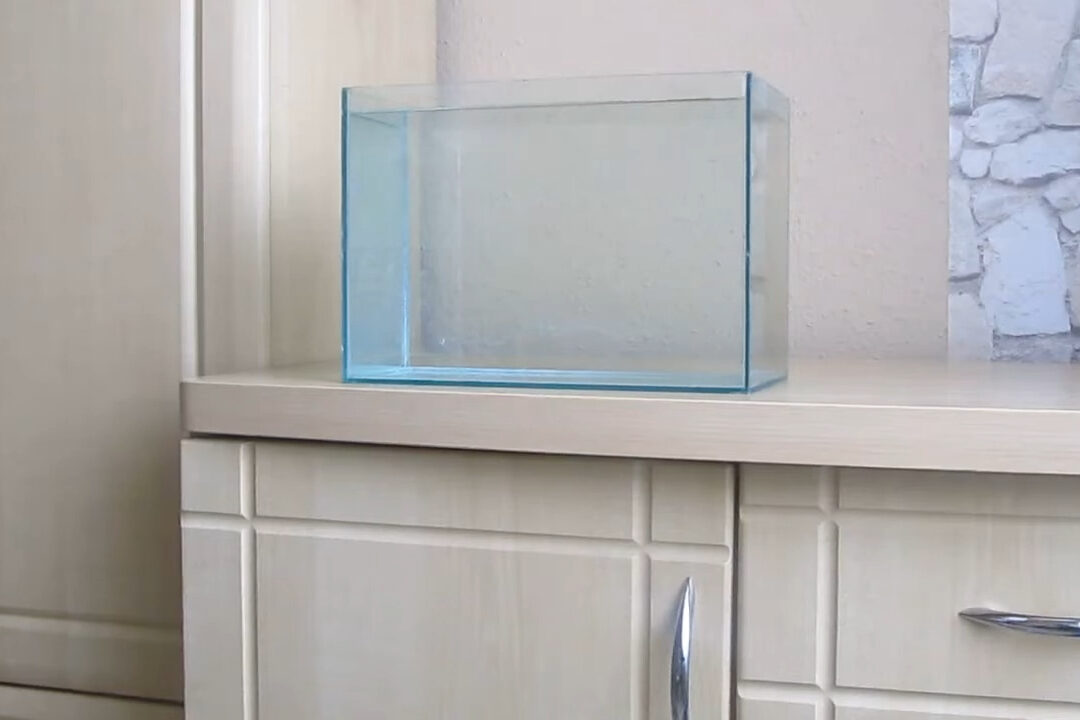
Fundamental Equipment
As you venture deeper into the world of aquarium care, it’s time to explore the essential equipment that will ensure the health and well-being of your aquatic companions and enhance the aesthetic appeal of your underwater realm. Let’s dive into the vital components that make up the backbone of a successful aquarium setup:
Filtration System
A reliable filtration system is the unsung hero of your aquatic ecosystem. Its primary role is maintaining water quality by removing impurities and toxins that can otherwise threaten your fish’s health. Here’s why investing in a good filter is non-negotiable:
- Debris Removal: Filters efficiently remove physical debris such as uneaten food, fish waste, and decaying plant matter. This keeps the tank visually appealing and prevents the buildup of harmful substances.
- Toxin Elimination: A high-quality filter also serves as a powerhouse for biological filtration, housing beneficial bacteria that break down harmful ammonia and nitrites. This biological filtration is vital for maintaining a stable and healthy aquatic environment.
When selecting a filtration system, consider the tank’s size, the type of fish you plan to keep, and the filter’s flow rate. A well-matched filter ensures efficient water circulation and optimal filtration performance.
Heater and Thermometer
Temperature regulation is a critical aspect of aquarium care, as it directly impacts the well-being of your aquatic inhabitants. Different fish species have specific temperature preferences, so it’s essential to maintain a consistent and suitable water temperature. Here’s how a heater and thermometer come into play:
- Heater: Depending on the needs of your fish, you may require a heater to ensure that the water temperature remains within the desired range. Tropical fish, for instance, often require warmer water than their cold-water counterparts. Investing in a quality heater with a thermostat can help you achieve and maintain the ideal temperature.
- Thermometer: A thermometer is your constant companion for monitoring the water temperature. It allows you to make necessary adjustments promptly and provides valuable insights into the effectiveness of your heater.
Combining a heater and thermometer creates a stable environment where your fish can thrive, free from the stress caused by temperature fluctuations.

Lighting
The right choice of lighting can transform your aquarium into a mesmerizing aquatic masterpiece. However, it’s not just about aesthetics; lighting plays a crucial role in supporting the life within your tank:
- Species-Specific Lighting: Different fish and plant species have varying lighting requirements. Some fish thrive under bright, natural lighting, while others prefer subdued, dimmer conditions. Similarly, aquatic plants rely on specific light wavelengths for photosynthesis. Research the lighting needs of your fish and plants to select the most appropriate fixtures.
- Circadian Rhythm: Just like humans, fish have a circadian rhythm. Providing them with a day-night cycle through controlled lighting helps maintain their natural behaviors and overall well-being.
Investing in the proper lighting setup enhances your aquarium’s visual appeal and contributes to your aquatic life’s vitality. [Read More About Lightning]
In summary, these essential equipment components—filtration, heating, and lighting—are the backbone of your aquarium setup. They ensure water quality, temperature stability, and the ideal lighting conditions necessary for the health and happiness of your aquatic inhabitants. As you gather these crucial tools, you’re one step closer to creating a thriving underwater paradise.

Creating the Ideal Environment
Now that you’ve assembled the fundamental equipment for your aquarium, it’s time to delve into the artistic and ecological aspects of crafting the perfect underwater world. Creating the ideal environment is not just about aesthetics; it’s about fostering a habitat that mimics the natural settings your fish and plants call home. Let’s explore the essential elements that go into crafting this harmonious aquatic haven:
Substrate Selection
The choice of substrate, the material that lines the bottom of your aquarium, is critical in replicating a natural aquatic environment. Here’s why it matters:
- Gravel and Sand: Gravel and sand are two standard substrate options. They serve as a decorative foundation and function in your tank’s ecosystem. The substrate provides a surface for beneficial bacteria to colonize, aiding biological filtration. Additionally, some fish species, like bottom-dwellers, appreciate certain substrate types for digging or sifting through for food.
- Fish Preferences: Research the specific needs and preferences of your fish. Some species, such as cichlids, prefer sandy substrates for digging, while others, like catfish, benefit from smooth, fine gravel. Tailoring your substrate to match the natural habitat of your fish can enhance their comfort and well-being.
Consider the aesthetic appeal and practicality of your chosen substrate, and remember that it’s not just a decorative element; it’s an integral part of your aquarium’s biological processes.
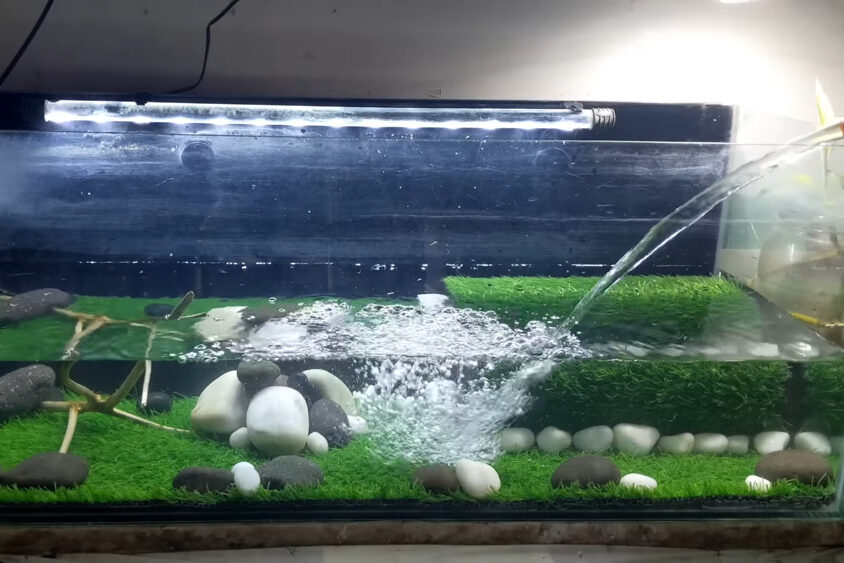
Aquatic Plants
Incorporating live plants into your aquarium offers a multitude of benefits, ranging from enhancing the visual appeal to supporting the overall health of your aquatic ecosystem:
- Natural Beauty: Live plants add a touch of natural beauty and tranquility to your tank, creating a captivating underwater landscape. They can mimic the lush, vibrant environments many fish and aquatic creatures call home.
- Water Quality: Plants play a vital role in maintaining water quality. They absorb excess nutrients, such as nitrates, helping to prevent algae blooms and maintain a healthy balance in your tank. Furthermore, they release oxygen during photosynthesis, providing a valuable source of aeration for your fish.
- Habitat and Hiding Places: Aquatic plants offer shelter and hiding spots for your fish, reducing stress and promoting natural behaviors. Fish often seek refuge among plants, mimicking their instincts in the wild.
When selecting aquatic plants, consider each species’ lighting requirements and growth patterns. Some plants thrive in low-light conditions, while others require more intense illumination. Plants’ careful selection and placement can transform your aquarium into a thriving aquatic oasis.
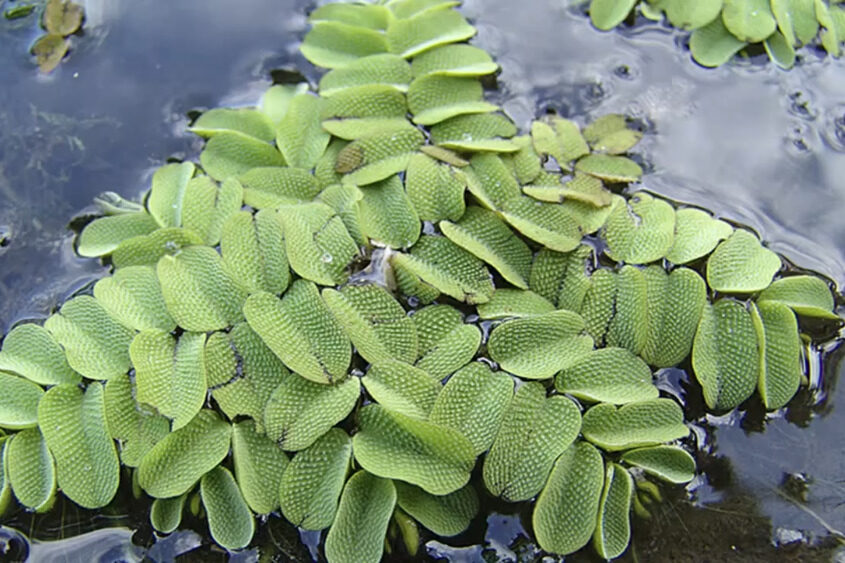
Decorations
Decorations are the finishing touches that bring your aquatic masterpiece to life. They serve both functional and aesthetic purposes:
- Habitat Enhancement: Decorations like driftwood, rocks, and caves provide essential hiding spots and territories for your fish. These structures mimic natural elements and can alleviate stress by offering a sense of security to your aquatic inhabitants.
- Aesthetics: Decorations can elevate the visual appeal of your tank, creating a more pleasing and visually stimulating environment for you and your fish. They can be tailored to match the theme of your aquarium, whether it’s a biotope recreation or a fantasy underwater world.
Remember that the arrangement of decorations should consider the needs and behaviors of your fish. Properly placed decor can foster a dynamic and engaging underwater landscape while respecting the preferences of your aquatic companions.
Crafting the ideal environment for your aquarium involves thoughtful consideration of substrate, including live plants, and strategically placing decorations. By combining these elements, you’re creating a visually stunning aquatic display and fostering a habitat that promotes the health and happiness of your fish. With each element carefully selected, you’re on your way to curating a thriving underwater sanctuary.
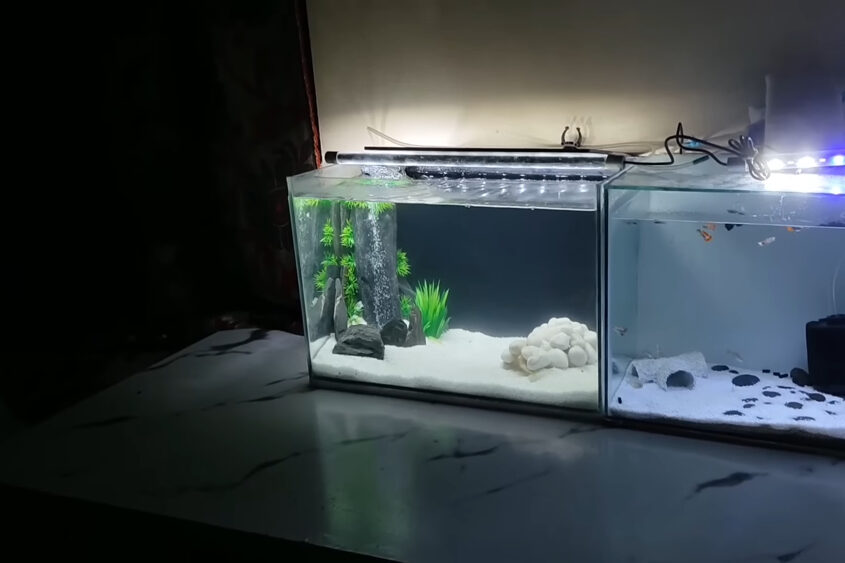
Water Quality Management
Maintaining pristine water quality is paramount to ensuring the health and happiness of your aquatic community. It’s not just about aesthetics; it’s about creating a safe and stable environment that mirrors the conditions of a natural aquatic ecosystem. Let’s delve into the crucial aspects of water quality management:
Water Parameters
Monitoring and managing water parameters is akin to conducting regular health check-ups for your fish. It’s essential to keep these key aspects of water chemistry within the appropriate range to prevent stress and maintain the well-being of your aquatic companions:
- pH Level: The pH level indicates the acidity or alkalinity of the water. Different fish species have varying pH preferences, so it’s vital to research and maintain the ideal pH range for your specific fish.
- Ammonia (NH3): Ammonia is produced by fish waste and decaying organic matter. Even trace amounts can be harmful, so keeping ammonia levels at or near zero is crucial. Beneficial bacteria in your filtration system help convert ammonia into less toxic compounds.
- Nitrite (NO2): Nitrite is another harmful compound produced during the nitrogen cycle in your aquarium. Like ammonia, it should be kept at minimal levels, preferably zero, to prevent harm to your fish.
- Nitrate (NO3): Nitrate is the final product of the nitrogen cycle. At the same time, less toxic than ammonia and nitrite, high nitrate levels can still excessively harm fish. Regular water changes help keep nitrate levels in check.
If necessary, regular testing with reliable aquarium test kits and adjustments will help you maintain stable water parameters, reducing the stress on your fish and promoting their overall health.
Water Changes
Performing routine water changes is akin to refreshing the air in a room; it revitalizes your aquarium’s environment by removing impurities and replenishing essential minerals. Here’s why water changes are crucial:
- Impurity Removal: Over time, organic waste, uneaten food, and other pollutants can accumulate in your tank. Water changes help remove these impurities, preventing the deterioration of water quality.
- Mineral Replenishment: Tap water typically contains essential minerals that may deplete in your aquarium over time. Regular water changes reintroduce these minerals, ensuring your fish and plants have the necessary resources to thrive.
- Dilution of Harmful Substances: If ammonia, nitrite, or nitrate levels rise above safe thresholds, water changes can help dilute these substances to safer levels. This is particularly important in the event of unexpected spikes in water parameters.
Aim for regular water changes, typically in the range of 10-20% of your tank’s volume every few weeks, though the frequency may vary depending on the size of your tank and the needs of your fish. Ensuring that the new water matches the temperature and pH of your tank will minimize stress on your aquatic inhabitants during water changes.
Water quality management is the linchpin of successful aquarium care. Regularly testing and adjusting water parameters and performing routine water changes are essential practices for creating and maintaining a thriving aquatic environment. By diligently attending to these aspects, you’re preserving your fish’s health and nurturing a vibrant and enduring underwater ecosystem.
Fish Selection and Compatibility
As you embark on your journey to create and maintain a thriving aquarium, paying close attention to the selection and compatibility of the fish that will inhabit your aquatic realm is essential. A harmonious and well-thought-out fish community can make your aquarium a mesmerizing spectacle. Here’s how to make informed choices and ensure the coexistence of your aquatic companions:
Research Fish Species
Selecting the right fish for your aquarium involves more than just picking the most attractive ones. Each species has unique requirements and behaviors that must be considered to create a harmonious underwater community:
- Water Conditions: Research the specific water parameters preferred by the fish species you intend to keep. Some fish thrive in soft, acidic water, while others prefer hard, alkaline conditions. Ensuring all your chosen species have similar water preferences can prevent stress and health issues.
- Temperament: Fish exhibit various temperaments, ranging from peaceful to aggressive. Consider the temperament of each species and their potential interactions. Aggressive fish may harass or even harm more docile species, while some species may thrive in groups, while others prefer solitude.
- Dietary Needs: Different fish have varying dietary requirements. Some are herbivores, others are carnivores, and some are omnivores. Ensure that the food preferences of your chosen species align to provide a balanced diet for all.
- Tank Size: Consider the space available in your aquarium and the adult size of your chosen fish. Overcrowding can lead to stress and territorial disputes, while a tank that’s too large can make fish feel vulnerable and stressed.
By thoroughly researching each fish species and understanding their unique characteristics, you can create a community that coexists peacefully and thrives within your aquarium’s parameters.
Introducing Fish
Introducing new fish to your established aquarium requires careful planning to minimize stress and potential conflicts:
- Gradual Introduction: It’s advisable to introduce new fish gradually. This can be done by placing them in a separate quarantine tank for a period of time. This step allows you to observe their health and helps them acclimate to your tank’s water conditions.
- Avoiding Territorial Disputes: In an established community, fish may have already established territories. When introducing new fish, rearrange decorations and hide spots to disrupt existing territories. This can help prevent territorial disputes and reduce aggression.
- Quarantine: Quarantining new fish is a prudent practice to prevent the introduction of diseases to your main tank. Isolate new arrivals in a separate tank for a few weeks, monitoring their health and treating any issues before adding them to the main aquarium.
By taking these precautions when introducing new fish, you can significantly reduce the risk of stress-related health problems and promote a smoother transition for both new and existing aquatic inhabitants.
The selection and compatibility of fish species in your aquarium are pivotal to its long-term success. Thorough research, consideration of water parameters, temperament, dietary needs, and the careful introduction of new fish will help you create a harmonious underwater community that flourishes and captivates. Your diligence in these matters ensures a serene and thriving aquatic realm for years.
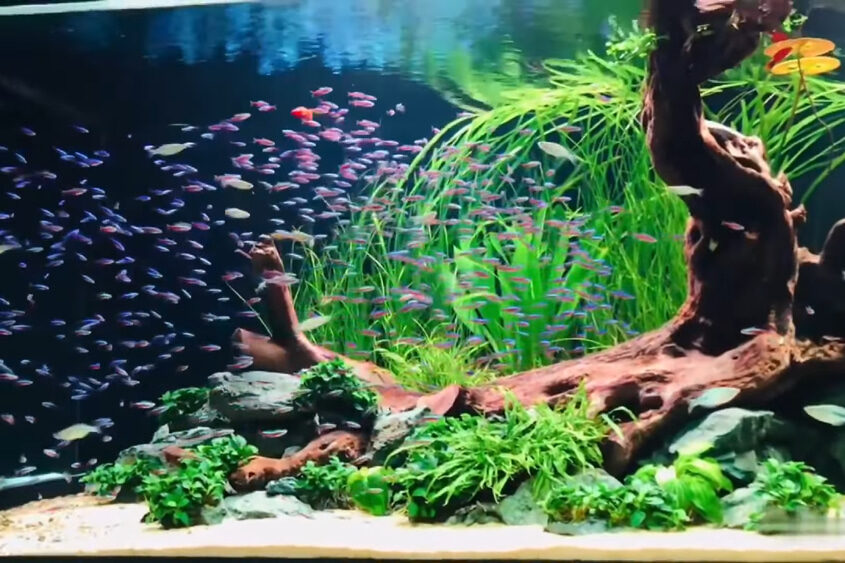
Feeding and Maintenance
As you nurture your underwater ecosystem, responsible feeding and meticulous maintenance are the keystones to a thriving and balanced aquarium. These practices ensure your aquatic companions’ health and vitality while keeping their environment pristine. Here’s how to manage feeding and maintenance effectively:
Feeding Schedule
A consistent and well-balanced diet is fundamental to the well-being of your fish. To achieve this, establish a regular feeding schedule and adhere to these principles:
- Research Dietary Needs: Understand the dietary requirements of each fish species in your aquarium. Different species have distinct nutritional needs, including the type of food (e.g., flakes, pellets, live, or frozen), feeding frequency, and portion size.
- Moderation: Overfeeding is a common pitfall that can lead to water quality issues and health problems for your fish. Offer small, manageable portions your fish can consume within a few minutes. Uneaten food should be removed promptly to prevent it from decomposing and fouling the water.
- Variety: Just as a balanced diet is essential for humans, it’s equally vital for fish. Rotate between different types of food to ensure your fish receives diverse nutrients. Commercial fish foods may not contain all the necessary nutrients, so consider supplementing with live or frozen foods when appropriate.
- Scheduled Feeding: Establish a consistent feeding schedule, typically 1-2 times daily, depending on your fish species. Feeding times should coincide with when your fish are most active and receptive to food.
By adhering to a well-planned feeding schedule and offering a variety of nutritionally balanced foods, you’ll contribute to the health and vitality of your aquatic community.
Tank Cleaning
Maintenance plays a crucial role in preserving water quality and the overall aesthetics of your aquarium. Regularly cleaning the tank’s interior is vital:
- Glass Cleaning: Algae buildup on the glass can obscure your view of the aquatic life within and diminish the aesthetic appeal of your tank. Use an aquarium-safe algae scraper or magnet cleaner to remove algae and maintain clear viewing panes.
- Decorations and Substrate: Periodically inspect and clean decorations, rocks, and substrates to remove detritus and waste that may accumulate. A siphon or gravel vacuum can help with substrate cleaning during water changes.
- Water Changes: As discussed earlier, routine water changes are essential for removing impurities and replenishing essential minerals. In addition to maintaining water quality, these changes help reduce the overall workload when cleaning the tank’s interior.
By incorporating regular cleaning into your aquarium maintenance routine, you’ll enhance the visual appeal of your aquatic paradise and contribute to your fish’s health and well-being.
Monitoring and Observation
Keeping a watchful eye on your aquatic companions is a proactive approach to early problem detection:
- Behavior and Health: Regularly observe your fish for any changes in behavior or signs of illness. Symptoms like lethargy, changes in appetite, abnormal swimming patterns, or visible physical abnormalities can indicate health issues.
- Water Parameters: Continuously monitor key water parameters, such as pH, ammonia, nitrite, and nitrate levels, to ensure they remain within the appropriate ranges. Fluctuations can stress your fish and compromise their health.
- Interaction: Pay attention to how your fish interact with one another. Aggressive behavior, excessive chasing, or bullying can harm or stress out individual fish.
By staying attentive and addressing issues promptly, you can prevent minor concerns from escalating into more significant problems, ultimately ensuring the longevity and well-being of your aquatic community.
Responsible feeding and meticulous maintenance are the cornerstones of a successful aquarium. Establishing a consistent feeding schedule, maintaining a clean tank, and actively monitoring your fish’s health and behavior create the ideal conditions for a thriving underwater ecosystem. With these practices in place, you can enjoy the beauty and serenity of your aquarium while providing the best possible care for your aquatic companions.
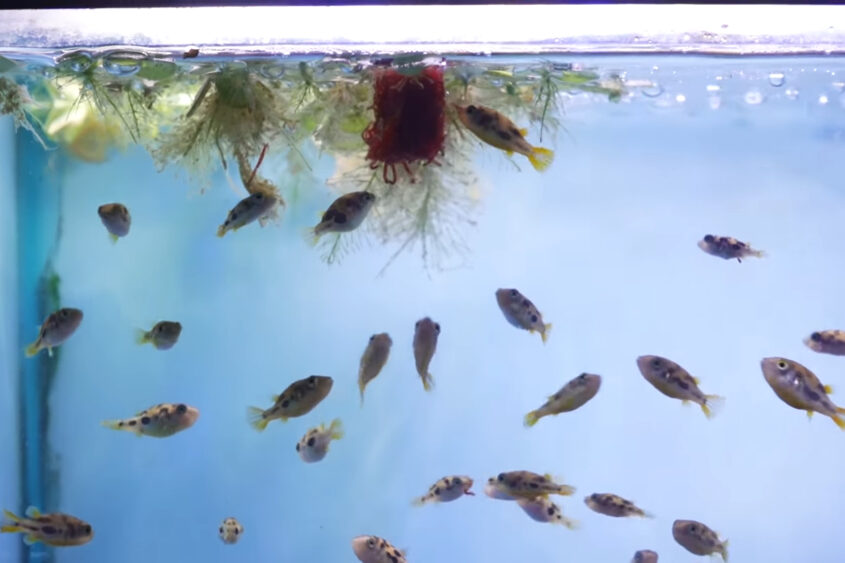
Conclusion
In conclusion, creating a thriving fish tank is a delicate blend of art and science. This guide has provided insights into essential aspects of aquarium care, from tank setup to fish selection, maintenance, and monitoring. Each aquarium is unique, and with patience and dedication, you can provide your fish with a healthy and visually captivating home, finding fulfillment in the art and science of aquarium keeping.
Frequently Asked Questions
How often should I clean my fish tank?
Regular tank maintenance, including water changes and cleaning, should be performed every few weeks, depending on your tank’s size and the number of fish.
Can I mix different fish species in the same tank?
Yes, but it’s essential to research and choose compatible species with similar water conditions and temperament to prevent conflicts.
What is the ideal water temperature for tropical fish?
Most tropical fish thrive in water temperatures between 75°F and 82°F (24°C to 28°C). However, specific species may have different requirements.
Do I need a water testing kit?
A water testing kit is essential for monitoring water parameters like pH, ammonia, nitrite, and nitrate to ensure a healthy environment for your fish.
How do I acclimate new fish to my tank?
To acclimate new fish, float the bag they came in on the water’s surface for about 15-20 minutes to allow temperature equalization. Then, gradually introduce them to the tank by adding small amounts of water to the bag over time before releasing them.
Remember, maintaining a fish tank can be a rewarding experience, and with the proper care, your aquatic pets will flourish in their underwater paradise.

